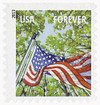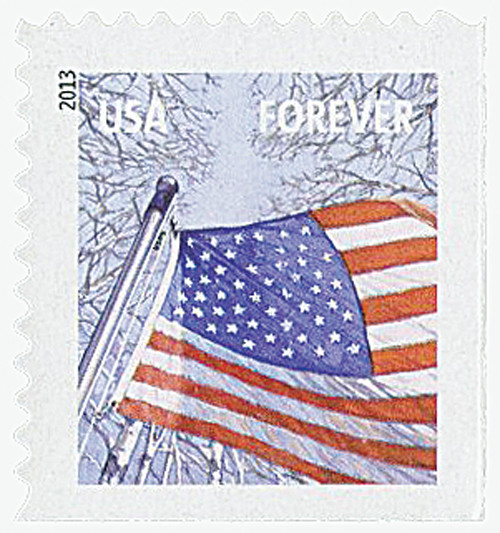
# 4782 - 2013 First-Class Forever Stamp - A Flag for All Seasons: Spring (Sennett Security Products, booklet)
U.S. # 4782
2013 46¢ Spring
A Flag for All Seasons
Until the Civil War, nearly all Americans pledged their loyalty to their state, not the nation. In the spring of 1861, rebel forces fired on Fort Sumter until the U.S. flag was lowered to signal surrender. According to tradition, when the Stars and Stripes went down at Fort Sumter, the flag went up in every loyal town and county in the North.
Major Robert Anderson was the commander of Fort Sumter during the April 1861 bombardment that triggered the Civil War. One of the terms of his surrender was that his men be allowed to fire a 100-gun salute to the U.S. flag before it was lowered. The banner was then taken north by Anderson to New York City, where it was auctioned during a fundraising tour. Winners donated the flag back each time so it could be used again in the next town.
As the South fell, Lincoln issued General Order No. 50, commanding Major Anderson to raise the original Fort Sumter flag over the garrison. The ceremony was held on April 14, 1865. While fireworks concluded the celebration in Charleston Harbor, Lincoln was assassinated at Ford’s Theater in Washington, D.C. Witnesses cradled the mortally wounded President’s head in a U.S. flag. Although nearly 150 years have passed since that spring day, the Lincoln and Fort Sumter flags still survive.
Laura Stutzman of Maryland created the patriotic gouache illustrations from her own photographs for the Flag for All Seasons stamps. Each of the four stamps in the issue pictures the U.S. flag, as seen from below, with the trees and sky representing the season.
Value: 46¢ 1-ounce first-class letter rate
Issued: May 17, 2013
First Day City: Rochester, NY
Type of Stamp: Definitive
Printed by: Banknote Corporation of America for Sennett Security Products
Method: Offset printing with Microprint “USPS” in booklets of 20
Perforation: Serpentine Die Cut 11 ¼ X 10 ¾
Self-Adhesive
Quantity Printed: 250,000,000 stamps
Though America’s flag had previously been used many times as a secondary design element, it wasn’t the subject of a stamp until 1957 (U.S. #1094). Since the 1980s, it has become a regular practice to issue stamps picture the U.S. flag in a variety of scenes, including different locations and times of day.
U.S. # 4782
2013 46¢ Spring
A Flag for All Seasons
Until the Civil War, nearly all Americans pledged their loyalty to their state, not the nation. In the spring of 1861, rebel forces fired on Fort Sumter until the U.S. flag was lowered to signal surrender. According to tradition, when the Stars and Stripes went down at Fort Sumter, the flag went up in every loyal town and county in the North.
Major Robert Anderson was the commander of Fort Sumter during the April 1861 bombardment that triggered the Civil War. One of the terms of his surrender was that his men be allowed to fire a 100-gun salute to the U.S. flag before it was lowered. The banner was then taken north by Anderson to New York City, where it was auctioned during a fundraising tour. Winners donated the flag back each time so it could be used again in the next town.
As the South fell, Lincoln issued General Order No. 50, commanding Major Anderson to raise the original Fort Sumter flag over the garrison. The ceremony was held on April 14, 1865. While fireworks concluded the celebration in Charleston Harbor, Lincoln was assassinated at Ford’s Theater in Washington, D.C. Witnesses cradled the mortally wounded President’s head in a U.S. flag. Although nearly 150 years have passed since that spring day, the Lincoln and Fort Sumter flags still survive.
Laura Stutzman of Maryland created the patriotic gouache illustrations from her own photographs for the Flag for All Seasons stamps. Each of the four stamps in the issue pictures the U.S. flag, as seen from below, with the trees and sky representing the season.
Value: 46¢ 1-ounce first-class letter rate
Issued: May 17, 2013
First Day City: Rochester, NY
Type of Stamp: Definitive
Printed by: Banknote Corporation of America for Sennett Security Products
Method: Offset printing with Microprint “USPS” in booklets of 20
Perforation: Serpentine Die Cut 11 ¼ X 10 ¾
Self-Adhesive
Quantity Printed: 250,000,000 stamps
Though America’s flag had previously been used many times as a secondary design element, it wasn’t the subject of a stamp until 1957 (U.S. #1094). Since the 1980s, it has become a regular practice to issue stamps picture the U.S. flag in a variety of scenes, including different locations and times of day.










